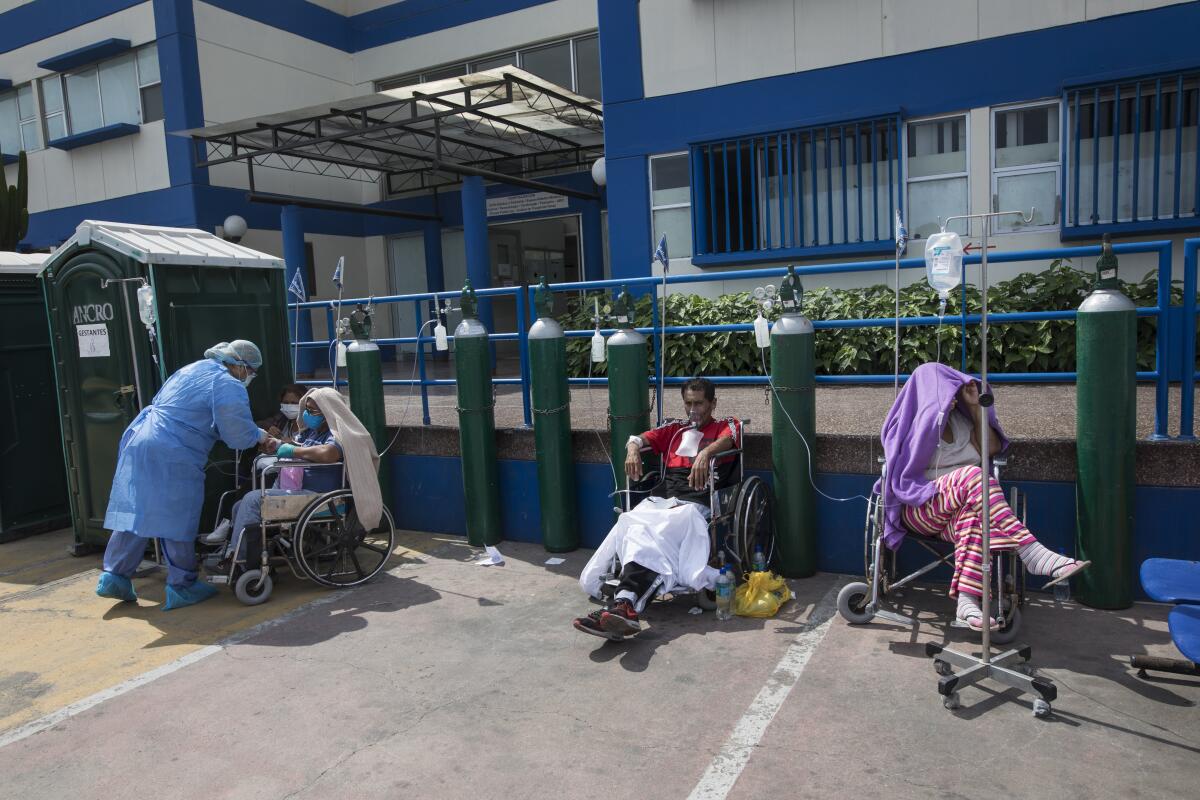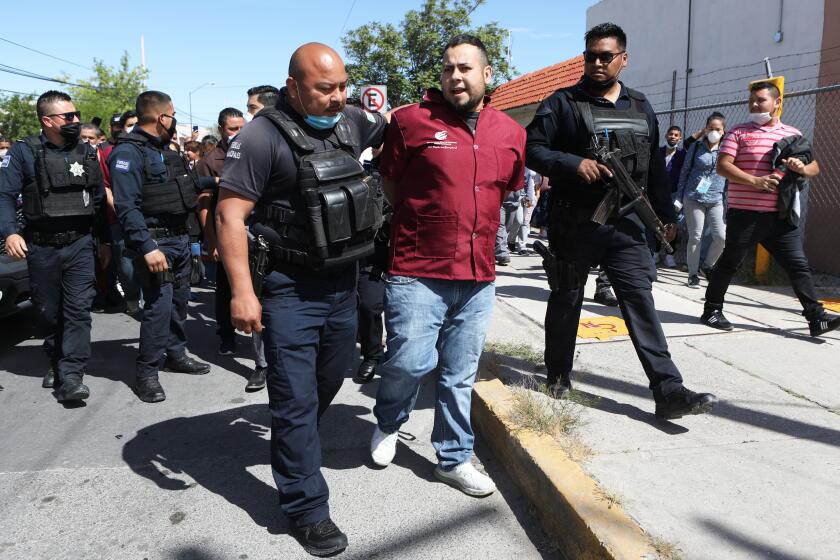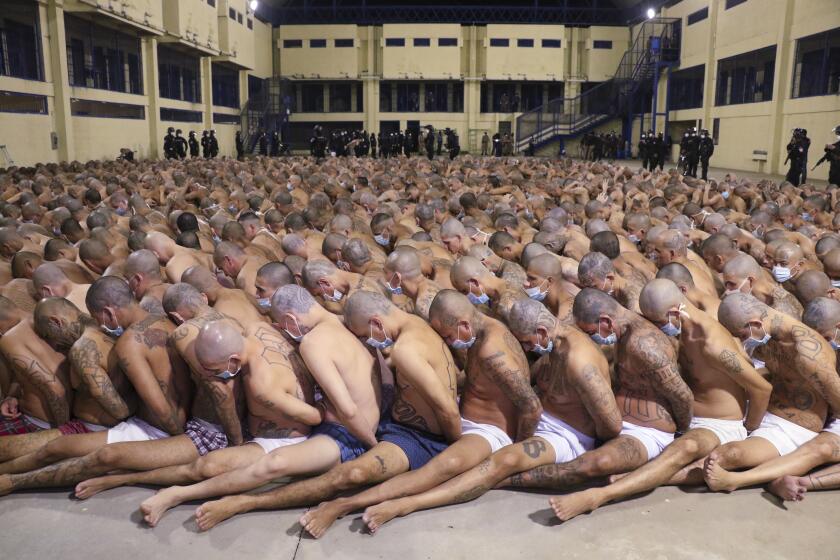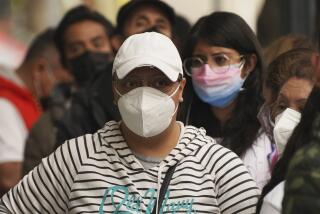Coronavirus charges beyond Latin America’s hot spots, threatening to overwhelm cities

- Share via
QUITO, Ecuador — Beyond the hot spots of Brazil and Mexico, the coronavirus is threatening to overwhelm Latin American cities large and small in an alarming sign that the pandemic may be only at the start of its destructive march through the region.
More than 90% of intensive care beds were full last week in Chile’s capital, Santiago, whose main cemetery dug 1,000 emergency graves to prepare for a wave of deaths.
In Lima, Peru, patients took up 80% of intensive care beds as of Friday. Peru has the world’s 12th-highest number of confirmed cases, with more than 99,000.
“We’re in bad shape,” said Pilar Mazzetti, head of the Peruvian government’s COVID-19 task force. “This is war.”
In some cities, doctors say patients are dying because of a lack of ventilators or because they couldn’t get to a hospital fast enough. With intensive care units swamped, officials plan to move patients from capitals such as Lima and Santiago to hospitals in smaller cities that aren’t as busy — running the risk of spreading the disease further.
Latin American countries halted international flights and rolled out social distancing guidelines around the same time as the U.S. and Europe, delaying the arrival of large-scale infection, said Dr. Marcos Espinal, director of communicable diseases at the Pan American Health Organization.
“Latin America was the last wave,” said Espinal, who previously worked at the World Health Organization.
He warned that authorities need to maintain anti-virus restrictions even as the U.S. and Europe reopen. Some of the hardest-hit cities, including Lima and Santiago, imposed strict, early lockdowns. But officials have struggled to enforce them, whether among the wealthy who are used to flouting regulations or lower-income people who depend on day labor or selling things on the street to feed their families.
Latin America is the world’s most unequal region, a reality that Espinal said made it difficult to balance health and economic growth, with millions facing increased poverty during quarantines, curfews and shutdowns.
A month after swamping the Ecuadorean coastal city of Guayaquil in one of the first serious blows to Latin America, COVID-19 is sickening thousands in the capital of Quito, where 80% of intensive care beds were occupied as of Friday.
“In terms of intensive care, we’re stripped bare,” city health secretary Lenín Mantilla said.
The United States wants Mexico to reopen its border factories, even as the coronavirus spreads and worker deaths rise.
Quito has more than 2,400 confirmed infections, and Health Minister Juan Carlos Zevallos said he expected the peak to come toward the end of June. He assured citizens that the city was prepared and would avoid the fate of Guayaquil, where hundreds died at home, left in living rooms for days before overworked coroners could retrieve the bodies. Those who perished in hospitals in coastal cities were put in chilled shipping containers that served as makeshift morgues.
The number of deaths in Quito jumped alarmingly over the weekend, from 114 to 209, and doctors said they dreaded the coming days.
“I have a 26-year-old woman next to me who walked in. Three hours later, she’s suffocating because we don’t have a respirator available,” said an intensive care doctor, who spoke on condition of anonymity because he was not allowed to speak to the media. “I think we’re getting to the point that you saw in Europe, where people died for lack of respirators.”
Ecuador, which has more than 34,000 total cases, has banned most private car trips and imposed a 2-p.m.-to-5-a.m. daily quarantine, but thousands of people can be seen buying from street vendors across the capital.
The worst-hit country in Latin America remains Brazil, which is third in the world for reported infections — at more than 260,000 — even with limited testing. More than 85% of intensive care beds are full in Rio de Janeiro and Sao Paulo.
The spreading specter of the coronavirus is shaking Latin America’s notoriously overcrowded, unruly prisons.
Now, other countries are surging. Chile has imposed new restrictions in Santiago after cases doubled over the last week. It has had more than 49,000 cases in all, in a country of 18 million people.
Under the new restrictions, people will have to receive a police permit to leave home, with violators fined the equivalent of thousands of dollars. Essential workers are exempted.
“We’re on very, very thin ice,” said Claudio Castillo, a professor of public policy and health at the University of Santiago.
In Colombia’s Amazon region, cases have shot up in recent weeks, from 105 at the start of the month to 1,006 on Monday. The infections are concentrated in Leticia, a city on the Amazon river that borders both Brazil and Peru.
Locals believe it’s related to the increase in cases in Brazil’s Amazon. Even though Colombia’s president has militarized the border, many still cross. Residents often work in one country and live in the other.
Leticia relies on two poorly equipped hospitals, which have about half a dozen respirators between them. Authorities recently began transporting seriously ill patients to Bogota, the Colombian capital, after a failure at a hospital oxygen plant. Officials said Monday that they will open hotels in Leticia to take in people with less severe COVID-19 cases.
Health workers also complain of limited access to testing and say they are overworked to the point of collapse.
In Mexico, intensive care occupancy is below 50% in most cities, although deaths have begun to overwhelm funeral homes and crematoriums in the Mexico City borough of Iztapalapa.
Meanwhile, in Quito, a growing number of people say they know someone who died of what was probably COVID-19, although many are not tested.
Marcelo López, who delivers food, said his 35-year-old cousin gargled with honey and ginger because he believed it would protect him from the virus. Unemployed, his cousin delayed going to a hospital this month even after feeling sick.
“When he finally acted, it was too late — he was seriously ill,” López said. “There were no ventilators in the hospital, and he died.”
More to Read
Sign up for Essential California
The most important California stories and recommendations in your inbox every morning.
You may occasionally receive promotional content from the Los Angeles Times.












